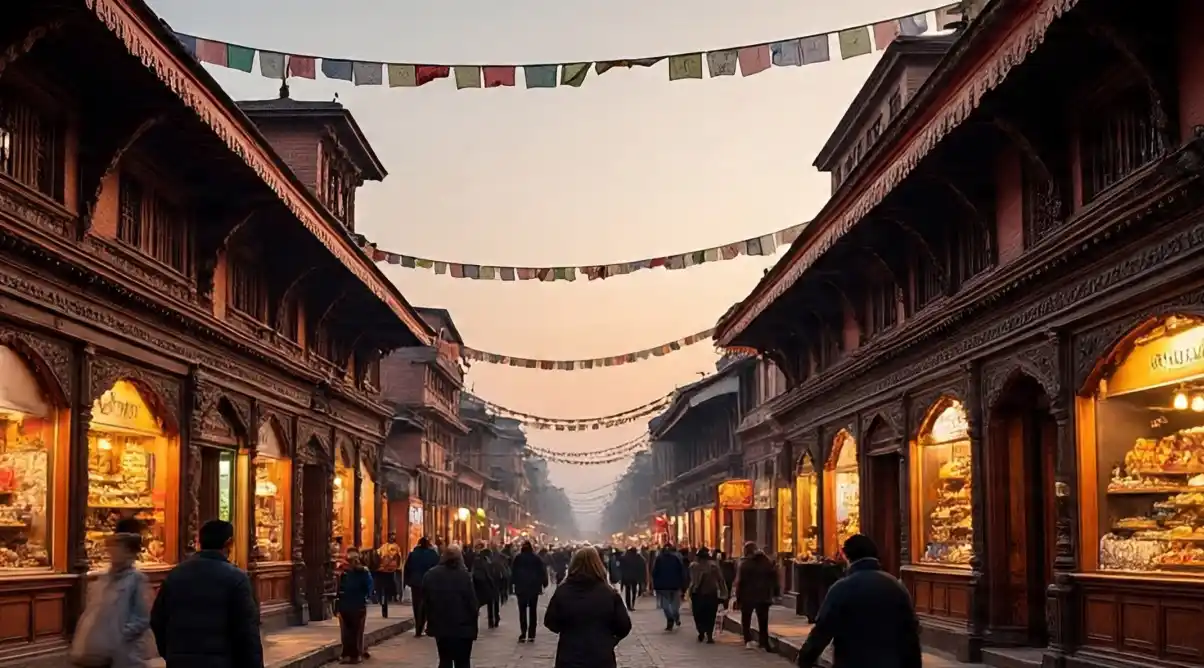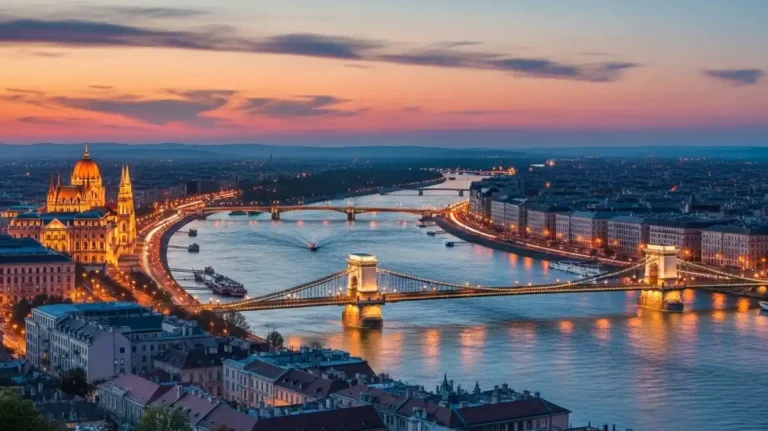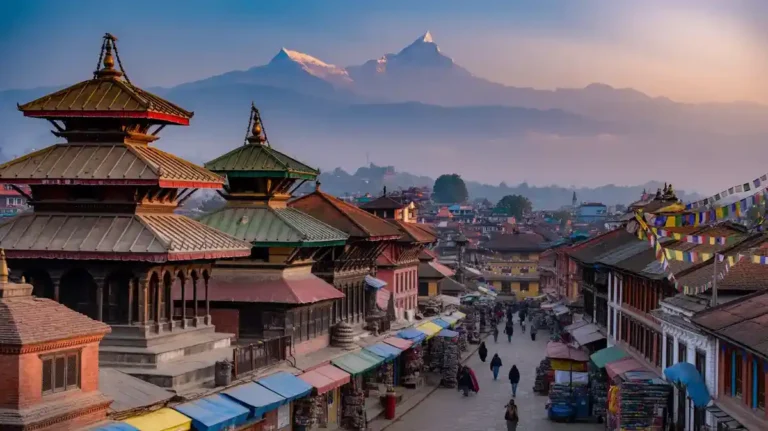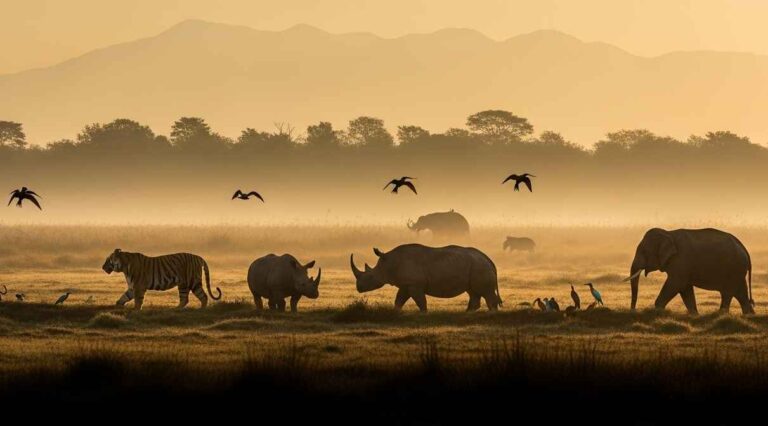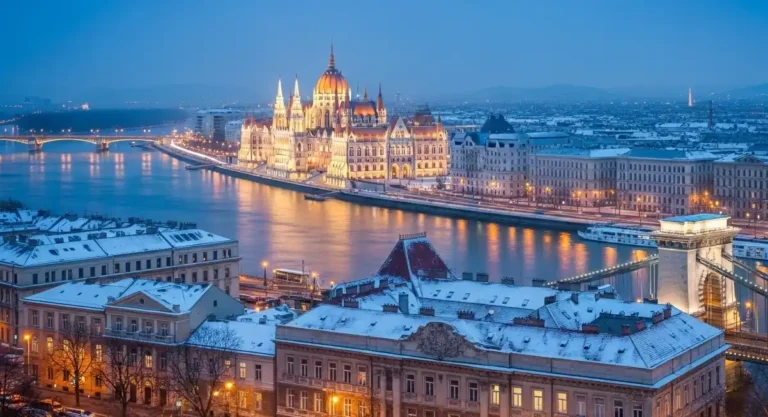The Ultimate Walking Tour of Kathmandu (You’ll Love #4!)
Kathmandu is a walkable city, especially in areas like Thamel, Patan, and Bhaktapur, where visitors can enjoy exploring on foot. These places offer pedestrian-friendly paths, vibrant streets, and a unique local experience.
Kathmandu offers a great experience for those who love to explore on foot. Areas like Thamel, Patan, and Bhaktapur are especially walkable and filled with touristy charm. These parts of the city are easy to explore, with sidewalks and inviting spaces that make walking enjoyable.
- Walkable City: Kathmandu is a walkable city, especially in areas like Thamel, Patan, and Bhaktapur, which offer pedestrian-friendly paths and rich cultural surroundings.
- Top Routes: Popular walking routes include Thamel to Swayambhunath (2.9 km, ~30 mins), Thamel to Ason Tole Market (1 km, ~10 mins), and Thamel to Kathmandu Durbar Square (1.1 km, ~15 mins).
- Cultural Experience: Walking allows for authentic exploration of hidden alleys, local markets, temples, and daily life scenes that vehicles can’t reach.
- Main Benefits: It offers cultural immersion, affordability, eco-friendliness, exercise, and a closer look at Kathmandu’s streets, heritage, and people.
- Possible Challenges: Some roads are narrow or uneven, sidewalks may be missing, intersections can be busy, and rainy season brings slippery paths.
- Stay Alert: Be cautious of scooters, street vendors, parked vehicles, and erratic traffic in busy or older areas.
- Safety Tips: Walk on sidewalks or face traffic, use crosswalks, keep belongings secure, avoid unlit areas at night, and stay connected with a local SIM.
- Local Etiquette: Remove shoes before entering temples or homes, walk clockwise around stupas, greet with “Namaste,” dress modestly, and use your right hand for giving and receiving.
- Offline Navigation: Use apps like MAPS.ME, Google Maps (offline), Mapy.cz (hiking), OsmAnd, HERE WeGo, and Peak Visor for detailed offline navigation.
- When to Walk: Walk for short distances, city sightseeing, or exploring clustered attractions; it’s ideal in good weather and well-known zones.
- When to Ride: Use transport for longer distances, time-sensitive travel, rainy days, or reaching suburban areas like Bhaktapur and outer Patan.
- Transport Options: Choose from taxis, ride-sharing apps (Pathao, Tootle), rickshaws, microbuses, Sajha Yatayat buses, and scooter rentals for flexibility.
- Water Safety: Tap water is unsafe to drink without treatment—use bottled, boiled, or filtered water and avoid ice from unknown sources.
- Main Attractions: Key walkable sites include Swayambhunath, Boudhanath, Pashupatinath, Kathmandu Durbar Square, Bhaktapur Durbar Square, Patan Durbar Square, and the Garden of Dreams.
- Cultural Highlights: Discover local food like momos and dal bhat, join guided walking tours, visit artisan workshops, experience heritage festivals, and enjoy peaceful temples on foot.
In the morning, the air feels fresh, making it a perfect time to run or take a peaceful walk. The outdoors becomes more friendly and welcoming. Though some roads may be narrow, they often lead to hidden gems and local scenes.
The infrastructure in these areas is improving, and walking around helps you notice the city’s poles, electricity cables, and cultural sights up close.
Kathmandu is designed with many paths worth discovering. With its colorful streets and active vibe, it’s a suitable place for a walking adventure. The overall quality of walking in these zones brings out the heart of the city.
Kathmandu on Foot: 6 Best Routes & Places to Explore
Kathmandu on foot offers a special way to really enjoy the city. You can immerse yourself in the local culture, rich history, and colorful atmosphere by simply walking. Many visitors prefer exploring on foot rather than using a taxi, even for short distances.
Joining walking tours or a guided group lets you see important historical sites, enjoy food-focused journeys, and explore local markets full of sights, sounds, and flavors. These explorations show you a side of the city that vehicles can’t. It’s a fun, close-up way to explore Kathmandu while staying active and engaged.
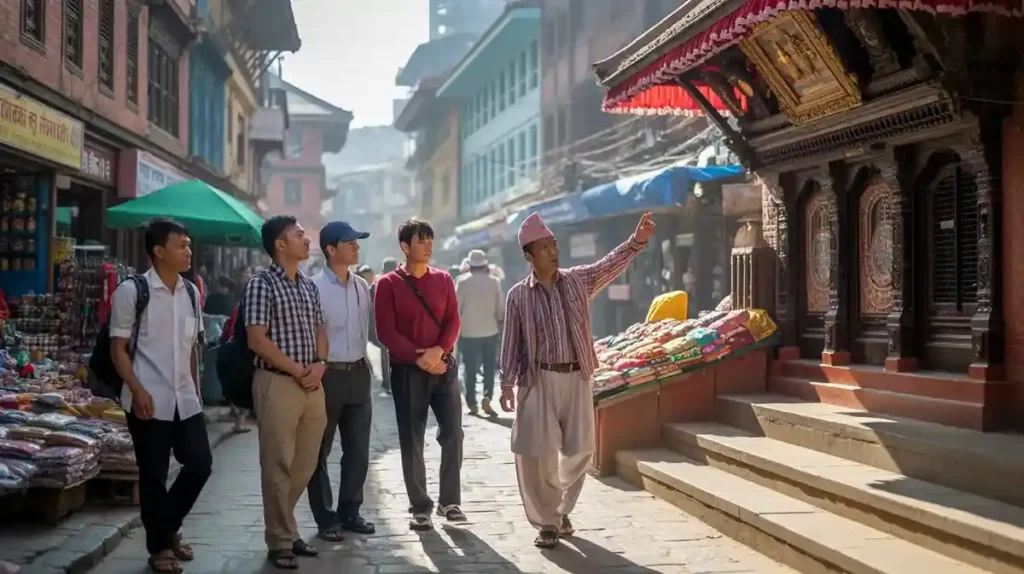
Thamel
Thamel is the heart of tourism in Kathmandu. Located in the northern part of the city, it’s filled with energy, color, and charm. This area is known for being friendly to visitors and full of life from morning till night.
Walking through the streets, you’ll see a blend of local shops, international cafés, cozy hotels, and lively restaurants. The area is easy to explore on foot, and every corner brings a new discovery—be it a small souvenir shop, a peaceful temple, or a colorful market.
For food lovers, Thamel offers a wide range of options, from Nepalese dishes to international cuisine. Bars, pubs, and live music venues add excitement in the evening, giving it a unique nightlife scene enjoyed by both locals and tourists.
The area is also a hub for adventure seekers. You’ll find stores selling trekking gear, walking gear, and other mountaineering items. Many travel agents operate here, making it easy to book trips or join a trekking group. Thamel even serves as a pre-base camp for mountaineers heading into the Himalayas.
Famous spots like the Garden of Dreams, Kathmandu Durbar Square, and Asan Market are close by. Designed in 1920, the Garden of Dreams offers a peaceful escape with beautiful fountains, pavilions, and urns—perfect after a day of exploring.
Thamel also reflects the deep cultural roots of Kathmandu. With ties to the Newa community and history dating back to the hippie days of the 1970s, it blends traditional heritage with modern vitality.
Whether you’re shopping for souvenirs, enjoying a cooking class, or meeting traveling companions, there’s something for everyone in this dynamic and welcoming part of the capital city.
Thamel to Swayambhunath (Monkey Temple)
The walk from Thamel to Swayambhunath (Monkey Temple) is about 2.9 km and takes around 30 minutes on foot. The route is peaceful, slightly uphill, and filled with cultural charm, ending at a sacred temple with beautiful views of the Kathmandu Valley.
The journey from Thamel to the Swoyambhu Stupa, also known as the Monkey Temple, is one of the most enjoyable short walks in Kathmandu.
It’s not too far—just a 30-minute walk—and the route offers a mix of calm streets and light uphill paths. This path is easy for most visitors, making it a reachable and rewarding experience for tourists of all ages.
As you walk, you’ll see locals going about their day and other people on the same travel route. Nearing the top, you’ll begin the climb up the stairs, leading to the sacred and spiritual hilltop temple. This destination is a must-see attraction and a proud part of the World Heritage Sites in the Kathmandu Valley.
The Swoyambhu Stupa is calm and colorful, surrounded by prayer flags and stunning views. The presence of friendly monkeys adds a fun touch to the visit.
Bring your camera, enjoy the peaceful space, and feel the beauty of this cultural landmark—a true gem for any tourist exploring Kathmandu.
Thamel to Ason Tole Market
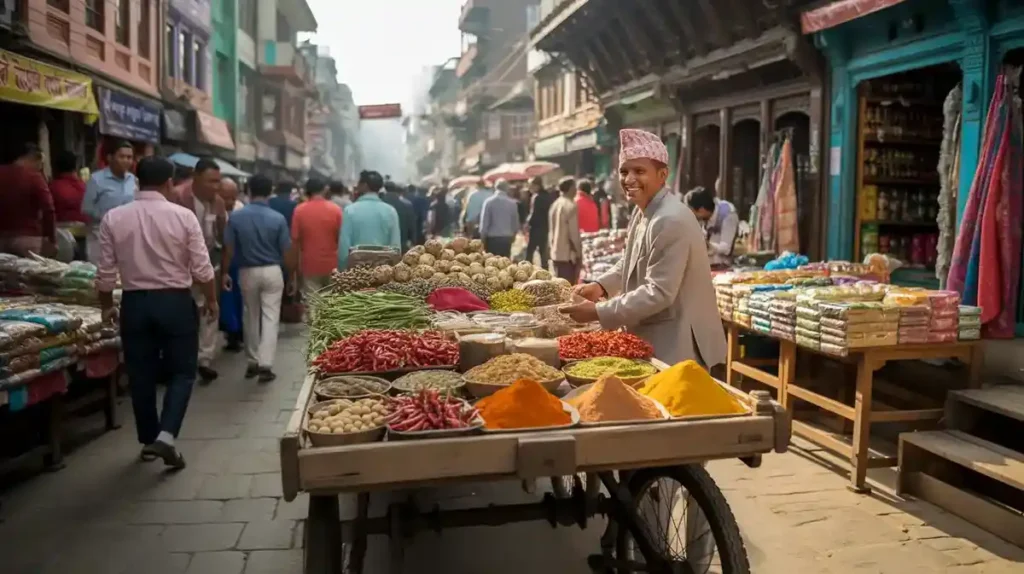
Walking from Thamel to Ason Tole Market is one of the most authentic ways to explore Kathmandu. The distance is just about 1 km, and it takes only around 10 minutes to walk.
Heading south along Siddhidas Marg, visitors get a charming glimpse of the city’s traditional charm and pre-motorized feel.
As you approach the busy intersection of Ason Tole, the streets come alive with a vibrant atmosphere. This market is full of local goods like spices, vegetables, tea, clothing, and household items.
It’s a lively place where both tourists and locals shop, meet, and enjoy everyday life.
If you’re not in the mood to walk, you can take a taxi, rickshaw, or even a local bus to the area. Still, the walk gives you the best experience, allowing you to connect with the streets, the people, and the unique rhythm of Kathmandu.
It’s more than just getting from one place to another—it’s a walk through culture, color, and the true spirit of Ason.
Thamel to Kathmandu Durbar Square
Walking from Thamel to Kathmandu Durbar Square is one of the easiest and most enriching things to do in Kathmandu. The Distance is only 1.1 km, which means you can get there in just about 15 minutes on foot.
Along the way, you’ll pass narrow lanes, local shops, and buildings that hold deep history.
Once you reach Durbar Square, you enter a World Site that includes ancient shrines, temples, and the royal palace. This former heart of the city has seen a prosperous past.
In the core of the town, life was once very active and concentrated—with the working class living on the southern side and the rich building shrines using their income to honor their god and goddess.
The platforms around the Square were important for social gathering. Elders used to chat, share matters, and listen to Bhajan’s—live singing of religious songs.
These platforms became peaceful places where the community could connect. Visitors today can still feel the charm and deep interest in the story of this place.
Whether you’re an explorer or someone just curious about the city’s past, this short journey offers something different. The route from Thamel to Durbar Square lets you walk through culture, history, and daily life—making it more than just a walk, but a memorable experience.
Bhaktapur
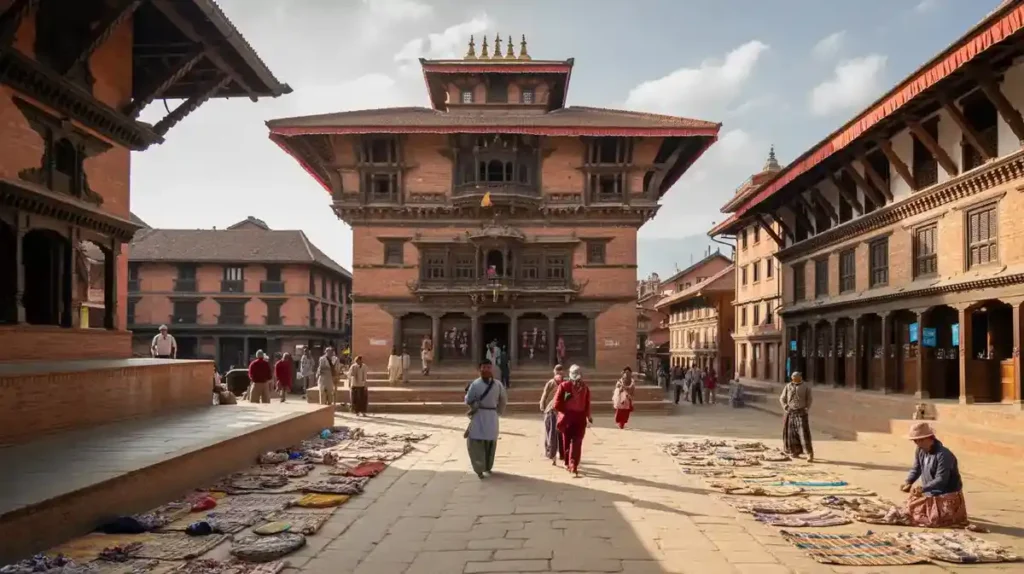
Bhaktapur is a beautifully preserved heritage city in Nepal, known for its ancient architecture, rich Newari culture, and vibrant art scene. Located just 15 km from Kathmandu, it offers visitors a peaceful, car-free experience with stunning palaces, temples, and traditional craftsmanship.
Tucked in the east corner of the Kathmandu Valley, Bhaktapur is one of Nepal’s most charming cities. Just 1 hour from the capital city by bus or taxi, it’s easy to reach and full of cultural treasures. Use Nepali taxi apps like Pathao to find the best taxi prices or enjoy a ride in a regular taxi.
This city, also known as Bhadgaon, Khwopa, or Khvapa, is a major Newar settlement and a vibrant example of Newari tradition, cuisine, and artisanship. Walking through the ancient city centre—which is completely car-free—feels like stepping into a living museum.
The cobbled streets lead to temples on every corner, bustling street markets, and local arts and crafts that showcase the heart of Nepali culture.
Bhaktapur Durbar Square, a World Heritage Site, is a highlight of the city. This elegant, open space is surrounded by historical buildings from the 13th century to the 18th century.
The Palace of 55 Carved Windows (Pachpanna Jhyale Durbar), the grand Golden Gate made in repoussé art, and statues like King Bhupatindra Malla on a giant stone pillar reflect the artistry of the Malla dynasty.
There’s more to discover at Taumadhi Square, Dattatrey Square, and Pottery Square, where local potters shape clay by hand. You can also join a thangka painting class, see Newari architecture up close, and taste delicious Newari food served in traditionally built Newari buildings.
Historic temples like the Batsala Temple, made in Shikhara-style architecture, feature intricate carvings and a bronze bell on the terrace, known as the Bell of Barking Dogs, installed in 1737 by King Ranjit Malla.
With its peaceful streets, deep heritage, and welcoming community, Bhaktapur stands out as the best preserved of the three main cities—alongside Kathmandu and Lalitpur—in this historic valley. It’s a must-visit on any trip to Nepal.
Patan (Lalitpur)
Patan (Lalitpur) is a culturally rich and artistic city in Nepal known for its ancient temples, fine metalwork, and vibrant heritage. Located just a few kilometers from Kathmandu, it is home to the iconic Patan Durbar Square, a UNESCO World Heritage Site, and showcases centuries of Hindu and Buddhist craftsmanship.
Located 5 km southeast of Kathmandu, Patan, also called Lalitpur, is one of the oldest cities in Nepal. Known as the City of Beauty, it blends stunning architecture, vibrant festivals, and masterful craftsmanship.
The city lies in the south-central part of the Kathmandu Valley, at an altitude of 1,400 metres (4,600 feet), surrounded by rich culture and history.
Patan Durbar Square is the heart of the city. This World Heritage Site is filled with lavish temples, grand palaces, and the famous Patan Museum. Visitors can enjoy museum exhibitions that highlight the city’s unique arts and crafts, including fine metalwork, repoussé, and lost wax sculptures made by skilled artisans and craftsmen.
The city is also known for religious harmony, with both Hindu temples and Buddhist monasteries (viharas). Temples like Mahaboudha Temple, Golden Temple, Kumbeshwar Temple, and Temple of Machendranath attract people from around the world.
Four Ashoka Stupas, said to be built by Mauryan emperor Ashoka around 250 BCE, sit on the city’s four sides, guarding it with spiritual significance.
With over 299,843 inhabitants (according to the 2021 census), Patan is a metropolitan city and the fourth most populous in Nepal.
It is a hub of cultural heritage, where daily life includes religious festivities, feasts, and colorful festivals. The city supports a strong tourism and agricultural economy, producing barley, rice, wheat, millet, vegetables, and fruit.
Walking through narrow streets and past brick houses, the sounds of tinkering tools echo from workshops where Newar metalworkers and wood-carvers continue their ancient practices.
These traditions, rooted in the times of the Licchavi, Thakuri, and Malla dynasties, remain alive and well. Lalitpur is not only a place to visit—it’s a place to experience living history.
Is Kathmandu safe?
Kathmandu is a safe and welcoming city for travelers. The locals are friendly, crime rates are low, and it’s generally safe for solo female visitors, especially when using common sense and reliable transportation.
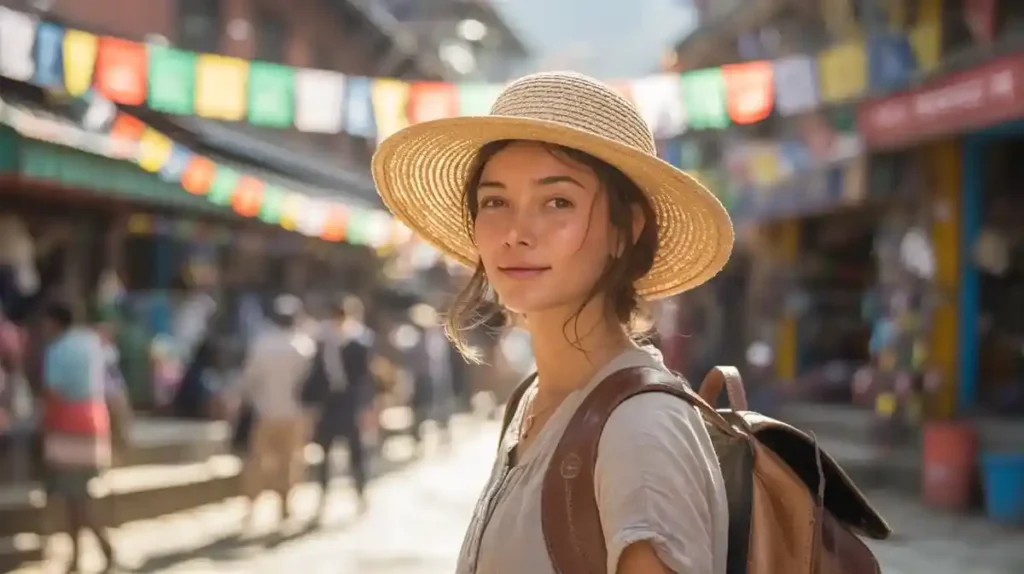
Kathmandu is known for its warm, welcoming atmosphere. Locals are genuinely friendly and helpful, making it easy for travelers to feel at ease. Whether you’re exploring busy markets or enjoying the peaceful corners of the city, the vibe is calm and respectful.
Solo female travelers often find Kathmandu to be safe, especially when being mindful and using common sense—like choosing reputable taxis or ride-sharing services. Many visitors appreciate how relatively easy it is to get around and connect with locals in a positive way.
Dressing modestly helps you blend in and avoid unnecessary attention, though it’s not enforced. Good transportation options make moving through the city easy and reliable. With a few simple precautions, visitors can enjoy Kathmandu with confidence and comfort.
Pros and Cons of Walking in Kathmandu
Walking in Kathmandu offers a beautiful balance between discovery and connection. The city is rich with culture, heritage, and everyday charm that you can truly experience only on foot. From lively streets to peaceful temples, walking lets you explore freely and at your own pace.
✅ Pros
- Deep cultural immersion and authentic local culture experience
- Easy access to hidden alleys, local shops, and temples
- Visit beautiful places like Patan, Bhaktapur, Swoyambhu Temple, and Kathmandu Durbar Square
- High attraction density makes everything feel close
- A cost-effective, budget-friendly way to travel
- Helps improve cardiovascular health and offers natural exercise
- Great for eco-conscious travelers
- Best way to observe and understand Nepal up close
- Accessible even where vehicles cannot go
🌿 Gentle Cons (Things to Keep in Mind)
- Some areas may have limited sidewalks or narrow roads
- It’s good to plan ahead for navigation in outer districts
- Be mindful of chaotic traffic and find safe pedestrian crossings
- Sunscreen is useful in summer months like June and August
- Certain roads may have parked vehicles, street vendors, or utility poles, so stay alert
- During the rainy season, watch out for puddles and wet paths
Walking in Kathmandu is not just about getting from one place to another — it’s about the experience. The sights, sounds, and slow pace allow you to absorb the city’s heritage and warmth in a way no ride ever can.
Safety Tips for Walking in Kathmandu
Walking in Kathmandu can be a rewarding and enriching experience when done safely. To enjoy the city’s vibrant culture and dynamic streets, it’s important to stay aware of your surroundings, respect local customs, and make smart choices regarding hydration, travel, and personal belongings.

Stay Aware of Your Surroundings
- Walk on sidewalks when available, or face traffic and stay close to the side when they’re non-existent.
- Cross streets at designated crosswalks or intersections.
- Be mindful of motorcycles, scooters, and all vehicle movement.
- In crowded areas like Thamel or Durbar Square, stay alert to keep your walk smooth and safe.
Keep Your Belongings Secure
- Carry only small denominations of cash for easy transactions.
- Leave passports and valuables in the hotel safe.
- Use reputable transportation services and registered taxis when needed.
- Choose accommodation with strong security and good reviews.
Eat and Drink Smart
- Drink bottled or purified water instead of tap water.
- Skip ice in drinks unless you’re sure it’s purified.
- Enjoy street food from vendors who maintain proper hygiene to avoid stomach issues.
Dress and Act Respectfully
- Dress modestly, especially near religious sites like temples and shrines.
- Be aware of local customs and always ask for permission before taking photos of people.
Stay Connected and Informed
- Keep a charged phone with emergency numbers saved.
- Get a local SIM card for better communication.
- Stay updated on weather and road conditions, especially during monsoon season, and plan accordingly.
- If going trekking, check forecasts and make sure your travel insurance includes medical and altitude coverage.
Walk with Confidence
- Wear comfortable closed-toe shoes with good support to handle uneven surfaces.
- Be aware of your footwear as you walk across the city’s historic and modern areas.
- Trust your instincts in all situations and feel free to ask locals or businesses for help or directions.
Exploring Kathmandu on foot is a wonderful way to connect with its charm. A little preparation ensures that your walk is not just safe—but also joyful and full of discovery.
Essential Walking Etiquette & Local Customs
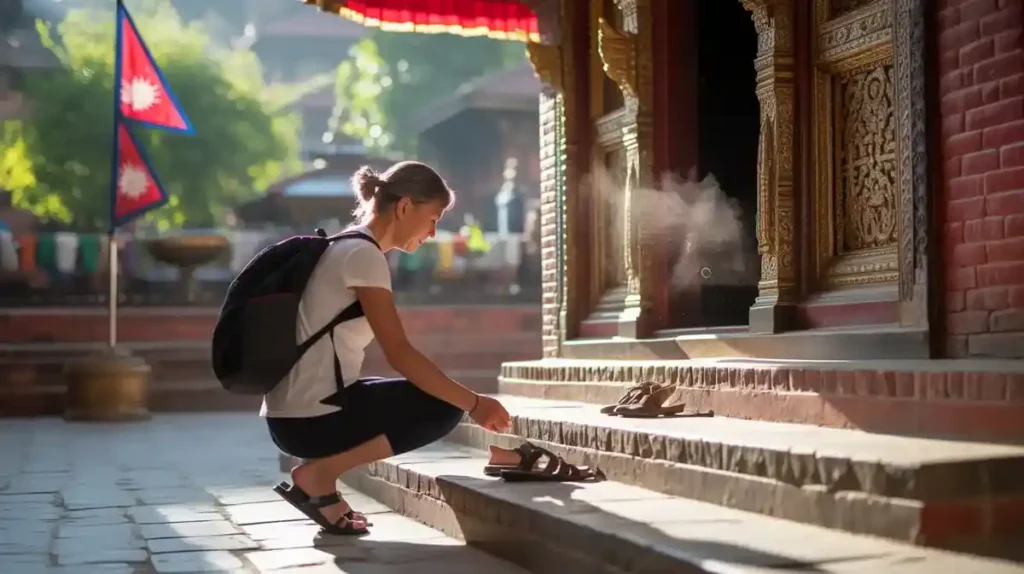
Essential walking etiquette and local customs in Kathmandu include removing shoes before entering sacred spaces, walking clockwise around religious sites, dressing modestly, greeting with “Namaste,” and showing respect through mindful actions.
Always ask before taking photos, use your right hand when giving or receiving, and follow local traditions with care and kindness.
Walking through the streets of Kathmandu is a journey into a place full of culture, faith, and warm-hearted people. The beauty of the city is not just in its shrines, temples, and stupas, but in the quiet ways people show respect and kindness every day.
Before entering any religious sites, homes, or sacred spaces, it’s respectful to remove your shoes. Locals walk clockwise around stupas and sacred stones, honoring spiritual beliefs.
The scent of incense, the sight of flowers as offerings, and the peaceful silence in these places remind visitors to be mindful and gentle in their steps.
Wearing modest clothing—covering your shoulders and knees—is appreciated, especially in villages or rural areas. A soft greeting of “Namaste” with joined palms and a light bow is a simple, powerful way to show respect when meeting someone.
If someone offers food or drinks, accepting them shows politeness and connection. Use your right hand when giving or receiving anything, as it aligns with local customs.
When taking photos, especially of monks, children, or elders, always ask for permission first, as some areas may have restricted photography.
In Kathmandu, every small act—how you walk, greet, or share—can reflect a deep respect for the city’s rhythm and traditions. Following these thoughtful etiquette practices allows travelers to feel welcomed and connected to the spirit of Nepal.
Best Offline Map & Navigation Apps for Kathmandu
Navigating Kathmandu is easy with the right offline map apps. Whether you’re exploring city attractions, remote trails, or mountain routes, these apps offer reliable help without needing an internet connection. Here’s a curated list of top apps that bring strong offline functionality, detailed maps, and traveler-friendly features.
1. MAPS.ME – Detailed & Free for Every Traveler
MAPS.ME is a favorite for many travelers. It offers free, offline access to detailed maps of Kathmandu and nearby areas. You can download maps and use them with no wifi or connection. The app also supports hiking, trekking, and shows points of interest.
2. Google Maps – Trusted and Easy to Use
Google Maps allows you to download a specific area and use it offline. It’s great for finding public transport, city directions, and exploring both urban and outside areas. It gives accurate navigation for different transportation modes.
3. Mapy.cz – Great for Hiking and Trekking
Mapy.cz is well-known among hikers. With rich trail data and offline maps, it helps you follow routes even deep in the mountains. It’s perfect for those who love to explore.
4. HERE WeGo – For Turn-by-Turn Navigation
This app is designed with strong turn-by-turn navigation and offline use. It includes transportation options and supports travelers looking for smooth city or road navigation.
5. OsmAnd – Open-Source Power with OpenStreetMap
OsmAnd is built on OpenStreetMap and offers detailed offline maps. It’s best for users who prefer open-source apps with customizable navigation features, including inclines, routes, and planning tools.
6. Peak Visor – Know the Mountains Around You
Perfect for mountain lovers, Peak Visor lets you use your phone to identify surrounding peaks. It works offline and helps turn your hiking into a smart exploration experience.
These apps blend useful capabilities with easy design, making them ideal guides for your journey through Kathmandu and beyond. Whether you’re walking through the city or trekking in the mountains, you’ll stay confidently on the right path.
When to Walk & When to Use Transport: Smart Mobility in Kathmandu
Use walking in Kathmandu for shorter distances, exploring tourist areas, and enjoying the city’s local atmosphere. Choose transport options like taxis, ride-sharing, buses, or rickshaws for longer trips, time-sensitive travel, and when visiting areas outside the main vicinity.
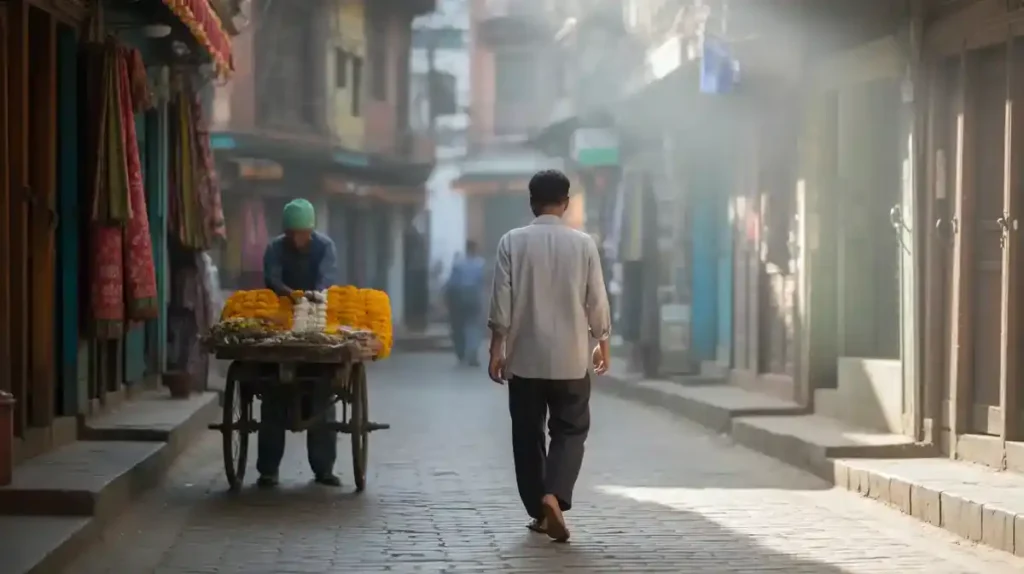
Walking is one of the best ways to enjoy Kathmandu. It’s perfect for exploring neighborhoods, visiting nearby attractions, or moving between places within a short radius.
Many tourist areas are pedestrian-friendly, making it easy to soak in the atmosphere and feel the pulse of the city. While walking, you get to discover hidden gems, appreciate the city’s unique character, and stay active and healthy.
For longer journeys or when you need to reach a destination quickly, using local transportation becomes more efficient. You can choose from ride-sharing, taxis, buses, or rickshaws depending on your needs.
These options are comfortable, affordable, and interesting—especially when you want to explore local life or go to areas not easily accessible by foot. In peak hours, while there might be congestion, public buses and other services often navigate the city more effectively, helping you stay on schedule and manage your time well.
Smart mobility in Kathmandu means knowing when to walk and when to choose the right transport options. It’s all about what works best for your travels, comfort, and experience.
Transportation Alternatives in Kathmandu Valley
Transportation alternatives in Kathmandu Valley include buses, microbuses, rickshaws, tempos, taxis, scooter rentals, and ride-sharing apps like Pathao and Tootle, offering affordable, convenient, and accessible ways for locals and tourists to explore the city and nearby areas like Bhaktapur and Patan.
Kathmandu Valley offers a wide range of travel options for both locals and tourists. From traditional buses and rickshaws to modern ride-sharing apps, getting around the Valley is both simple and exciting. Whether you’re commuting through major routes or exploring historic towns like Patan and Bhaktapur, transportation is readily available.
Those seeking public transport will find a mix of microbuses, minibuses, and Sajha buses. Sajha Yatayat, a government-run service, provides clean, green buses that operate across the city. These are especially useful for covering shorter distances within the busy streets of Kathmandu and beyond.
If you prefer something faster or more adventurous, scooter rentals and motorbikes offer a thrilling option for navigating the city. These are great for travelers who enjoy flexibility and speed. Services like Pathao and Tootle make it even easier with ride-sharing through easy-to-use apps.
Beautiful Points of Public Transportation in Kathmandu Valley:
- ✅ Affordable and cost-effective
- ✅ Easy access to local and tourist areas
- ✅ Multiple options to suit different travel needs
- ✅ Green, eco-friendly choices like Sajha buses
- ✅ Reliable for daily commuting
- ✅ Covers key locations like Thamel, Patan, Bhaktapur
- ✅ Available offline and online with minimal effort
From tempos to tuk-tuks, transportation in Kathmandu Valley is filled with common yet unique ways to move. Whether you’re a first-time visitor or a frequent traveler, there’s always a convenient, affordable, and accessible way to get where you want to go.
Is Tap Water Safe to Drink in Kathmandu?
Tap water in Kathmandu can be used safely if properly treated. Boiling, filtering, or choosing bottled water is commonly recommended for clean and healthy drinking.

While exploring Kathmandu during your trip, you’ll notice that tap water is part of daily life in many urban areas of Nepal. However, to make it safe for consumption, it’s best to boil or filter the water before you drink it. Many travelers and locals also stick to bottled options for ease and confidence.
Using a personal filter bottle is a smart way to enjoy local water safely. It’s also recommended to purchase one before your trip for added peace of mind. With simple care, like treating the tap water, you can stay hydrated and healthy throughout your journey—without worry.
What is Kathmandu famous for
Kathmandu is famous for its rich history, vibrant culture, sacred temples, and stunning UNESCO World Heritage Sites like Swayambhunath and Boudhanath. It is also the main gateway to the Himalayas and a hub for trekking and spiritual experiences.
Kathmandu is a place filled with wonder and tradition. As the cultural heart of Nepal, it is known for its beautiful Durbar Squares, ancient temples, and peaceful stupas.
The city’s UNESCO World Heritage Sites, such as Swoyambhunath (Monkey Temple), Boudhanath Stupa, and Pashupatinath Temple, attract people from around the world for their religious significance and beauty.
The city also offers a deep look into Hindu and Buddhist traditions, with many monasteries, rituals, and spiritual places. Travelers often begin or end their trip to Nepal in Kathmandu, thanks to its international airport in Tribhuvan. It is a natural starting point for adventures to Everest, Annapurna, and other Himalayan peaks.
Beyond the spiritual and historic charm, Kathmandu is full of energy. The markets of Thamel, local restaurants, and craft areas like Thimi (famous for pottery) show the bustling, lively atmosphere of city life.
Art lovers enjoy Thangka paintings, woodcarvings, and architectural marvels from the Malla dynasty. The blend of rural charm and urban history makes the capital a truly special hub of the country.
What to do in Kathmandu

Kathmandu offers a mix of ancient culture, stunning temples, local food, vibrant markets, peaceful gardens, and adventure activities like hiking and biking. Explore historic sites, experience local life in Thamel, visit sacred temples, or relax in beautiful spots like the Garden of Dreams.
Kathmandu is a colorful city full of culture, tradition, and natural charm. From sacred temples to lively streets, it gives you many ways to enjoy and explore. Whether you’re a history lover, a food explorer, or someone who enjoys mountain air, Kathmandu has something special waiting
Discover Sacred and Historic Places
- Durbar Square: A UNESCO World Heritage Site, filled with ancient royal palaces, temples, and beautiful Newari architecture.
- Swayambhunath (Monkey Temple): A hilltop stupa with panoramic views of the city and playful monkey inhabitants.
- Pashupatinath Temple: A holy Hindu temple by the Bagmati River, important for its cultural and spiritual energy.
- Boudhanath Stupa: The largest stupa in Nepal, surrounded by prayer wheels and Tibetan Buddhist culture.
- Patan & Bhaktapur Durbar Squares: Historic sites with pottery squares, stunning carvings, and timeless charm.
Explore Local Markets and Streets
- Thamel: A lively area full of shops, souvenirs, delicious food, and fun nightlife.
- Indra Chowk & Asan Bazaar: Bustling markets filled with local goods, handicrafts, and daily life.
- Pilgrims Book House: A perfect stop for unique souvenirs, travel books, and cultural gifts.
Relax and Reconnect
- Garden of Dreams: A quiet, neoclassical oasis in the heart of the city to relax and unwind.
- Kopan Monastery: A peaceful place to learn about Buddhism or join a meditation course.
- Tibetan Singing Bowl & Healing Center: Try gentle sound therapy for peace and balance.
For Adventure Seekers
- Day hikes and mountain biking: Enjoy natural trails, scenic routes, and fresh mountain air.
- Everest Base Camp Trek: A once-in-a-lifetime adventure to the world’s highest peak.
Taste Local Flavors
- Eat Nepali food: Try hot momos (dumplings) and flavorful Chiya (tea) in cozy tea houses.
- Walk through street food stalls and enjoy local favorites in the vibrant city corners.
Kathmandu offers both peaceful corners and energetic streets. It’s a place where every traveler finds a reason to smile, whether watching prayer flags flutter or sipping sweet tea with locals.
Conclusion
Kathmandu is a great place for walking. The city is full of color, culture, and small streets that are easy to explore. Many parts of Kathmandu are close together, so you don’t need a car to get around. It feels good to move slowly through the streets and enjoy the local shops, food, and temples.
While you’re walking outside, it’s smart to pay attention to the road and traffic, as it can be busy. Some helpful recommendations are to wear a face mask to protect yourself from air pollution and to watch out for puddles and ditches after rain. People usually feel safe, and the area is friendly for people who like to walk.
If you’re crossing the street, just take your time and look both ways. Many locals walk every day, and it’s part of normal life here. The city is truly walkable, and with a few simple tips, your walk can be fun and easy.
FAQs: Is Kathmandu a Walkable City?
Is Kathmandu a walking city?
Yes, Kathmandu is a great city for walking, especially in places like Thamel, Patan, and Bhaktapur. These areas have lively streets and many paths that are easy to explore on foot. Walking lets you see the city’s culture up close.
Is it safe to walk around in Kathmandu?
Yes, it is safe to walk around in Kathmandu. Locals are friendly, and the streets in tourist areas are welcoming. Just stay aware of your surroundings, and you’ll enjoy the experience.
Is it easy to get around Kathmandu?
Yes, getting around Kathmandu is easy. You can walk to many nearby places or use taxis, rickshaws, and ride apps for longer trips. Tourist areas are close to each other and easy to reach.
Is Kathmandu accessible?
Yes, parts of Kathmandu are accessible. Tourist areas like Thamel and Bhaktapur have flat paths and walkways. For better comfort, plan ahead, especially for older visitors or those needing extra support.
Is it safe to walk in Kathmandu at night?
Yes, walking in popular areas like Thamel at night is generally safe. The streets stay active and well-lit. Stay in busy places and walk with confidence to enjoy the evening charm.
Can you explore Kathmandu without using a taxi?
Yes, you can explore much of Kathmandu on foot. Many major spots are close to each other. Walking lets you enjoy the local sights, sounds, and culture better than driving.
Is Kathmandu walkable for elderly travelers?
Yes, Kathmandu is walkable for elderly travelers, especially in Bhaktapur, Patan, and Thamel. These areas are calm and easy to move through. Just wear good shoes and take breaks when needed.
Are there guided walking tours in Kathmandu?
Yes, there are many guided walking tours in Kathmandu. These tours take you to temples, markets, and food spots. It’s a fun way to learn and explore with a group.
What footwear is best for Kathmandu streets?
Closed-toe shoes with good grip are best for Kathmandu. The streets can be uneven, so wear comfy shoes that support your feet. This helps make your walks smooth and safe.
Where to walk around in Kathmandu?
You can walk in Thamel, Kathmandu Durbar Square, Patan, Bhaktapur, and the path to Swayambhunath. These places are full of life, history, and local charm. They’re perfect for a walking adventure.
Can I use a stroller in Kathmandu?
Yes, you can use a stroller in Kathmandu, but choose smoother areas like Bhaktapur and Patan. Some roads can be bumpy, so a stroller with strong wheels works best.
Disclaimer
This guide is for general travel information. Always check local conditions before walking. © traveldrizzle.com – your trusted guide to thoughtful travel.
